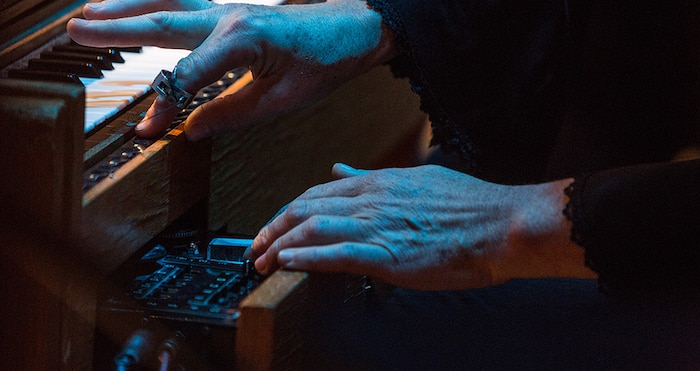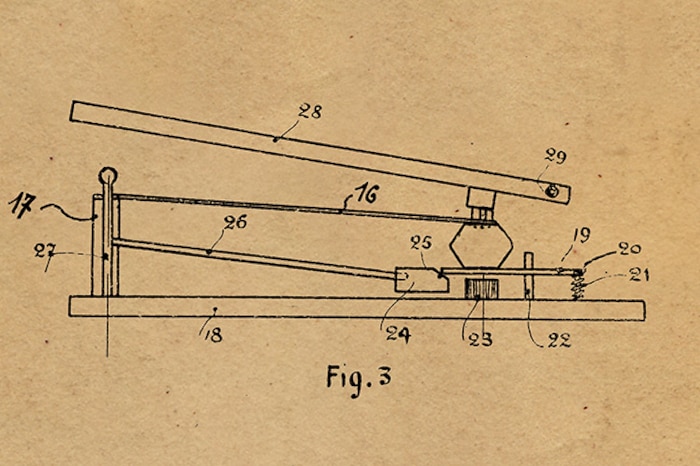Ondes Martenot: An Introduction
A favorite of Radiohead’s Jonny Greenwood and classical composer Olivier Messiaen, Andy Battaglia explains the origins and appeal of the ahead-of-its-time electronic instrument.

If history has taught us anything, it’s that the future is in the past. Even the most radical lurches or swerves, in retrospect, come to make sense. The wildest anomalies can seem preordained, even fated.
It’s especially true on the timeline of technology, in which the logical language of developers tells tales of tools being bettered and then bested – all in the service of ideas and desires said to be shared by all. So what to make of the Ondes Martenot, an enigma of an electronic instrument that is largely forgotten and yet, somehow, still only just now getting its due?
Proponents of the Ondes Martenot these days include Radiohead’s Jonny Greenwood, Gorillaz, Tom Waits, and Daft Punk, who featured one in the swooning “Touch” on Random Access Memories. But the story begins with an enterprising Frenchman playing around with telegraphy and radio waves during the earliest years of the electrical age.

Prior to his enlistment in the military in World War I, Maurice Martenot was a cellist, and his fondness for strings and bows figured into the contraption that bears his name. Like the still technologically astounding Theremin, the Ondes Martenot drew on the emerging practice of “heterodyning,” or combining different radio frequencies to make new ones by way of oscillator controls. But unlike the Theremin, whose wave effects are materialized by hands moving through the air, Martenot’s instrument was controlled by physical, palpable touch.
The sounds were similar and in some ways the same, but the Ondes Martenot was more advanced musically – more controllable and diverse and, to those who favored it, more expressive for the player at its controls. A player put a ring around a finger on their right hand and slid it, side to side, along a metal wire, triggering different pitches along the way. Additional controls in a small pull-out drawer by the left hand altered volume and articulation of sound. Different iterations of the instrument over the years enlisted proprietary speakers that offered still more options for timbre and tone. Playback choices ranged from a conventional loudspeaker to another fashioned like a metal gong. (See here, around 1:42, for a good explication of the different speakers – including the one operated in a way analogous to yelling into the body of a piano to make its strings vibrate sympathetically.)
Extra sound possibilities eventually came from a bonus keyboard. The first ones were fake: Martenot first added a simulacrum of piano keys below the sliding wire, just to give the player a sense of where he or she was in terms of pitch. Later versions of the instrument included a functional keyboard to be played, along with the wire, in full.
All of that made for an array of electronic tones that sound to contemporary ears like an alien strolling through a spaghetti western. Indeed, the Ondes Martenot has figured prominently in soundtracks for numerous movies, from its own era to the present day. “Always something with ghosts or aliens,” according to Thomas Bloch, a contemporary ondist who cited its use in Ghostbusters, Fantomas, and Mars Attacks! It also featured in other films including 1960’s Faces in the Dark and the epic Lawrence of Arabia (whose soundtrack was composed by Maurice Jarre, father of Jean Michel).
More important than its role in movies, though, is its standing as a featured instrument in works by certain master composers of the 20th century. Olivier Messiaen made early use of the Ondes Martenot in Fête des belles eaux, written to accompany majestic fountains at the International Exposition for Art and Technology in Modern Life in Paris in 1937. Edgard Varese enlisted it in Ecuatorial, originally written for the Theremin but later revised for Ondes Martenot instead. Giacinto Scelsi summoned the sound for his eerie, scintillating 1966 composition Uaxuctum. Bernard Parmegiani drew on one for his spacey, bracing blast-off electronic piece Outremer from 1969. And any list should make more space for Messiaen: The composer of so many transporting and ethereal (and weird) classical music works made frequent use of the Ondes Martenot in iconic masterpieces Turangalila Symphony and the opera Saint Francois d’Assise.
Martenot wanted to use electricity to increase and control the expression, the musicality.
Composers of such a distinguished sort were seduced by more than the instrument’s obvious novelty. “The Ondes Martenot is probably the most musical of all electric instruments,” explains Bloch, whose repertoire ranges from classical recitals to looser studio jams (he was the ondist hired by Daft Punk for “Touch”). “Martenot was not only interested in sounds. He wanted to use electricity to increase and control the expression, the musicality. Everything is made by the musician in real time, including the control of the vibrato, the intensity, and the attack. It is an important step in our electronic instrument lineage.”
Allowing for nuance and dexterity remains a holy grail for electronic instrument makers decades later – and maybe even more so now, with the novelty of old notions of synthesis and simulation aging out and being replaced by a desire for more refinement. Examples abound, from work by the California instrument designer Roger Linn to new imaginings like the soft, squishy, surreal Seaboard.
Caroline Martel, director of a new documentary on the Ondes Martenot titled Wavemakers, sees a connecting line between inventions of the past and ongoing experiments in the present. “It’s one of the first electronic instruments, but the key thing for Martenot to emphasize was that the instrument was using electricity but the music was not electronic – it was human,” she said. “The beauty of the [Ondes] Martentot is that it really bridges together the best of both worlds.”
Along with its wires and triggers and knobs was the inclusion of an almost supernatural kind of powder that transferred electrical currents.
Martel’s film – which premiered last year at the Rotterdam Film Festival and ramps up worldwide distribution this year – plays as an appreciation of the Ondes Martenot for musicians and bugged-out listeners alike. Some of the most fascinating portions of the film showcase how the Ondes actually works, and how the prospect of re-building the instrument to its original specs has proven elusive. Along with its wires and triggers and knobs was the inclusion of an almost supernatural kind of powder that transferred electrical currents within a certain part (under the expression key, which tweaked the timbre). Martenot himself would mix the powders to different musicians’ specifications, making the precise recipe hard to discern. “You must put in the right amount of explosive,” says a subject in the film, while mixing in some graphite. The wrong amount is much more likely, alas.

On top of that is the archaic template for wiring an instrument invented when the age of wires was still new. The innards get called “hyper-mega fragile” at one point in the film, and numerous scenes are given over to false starts and faulty constructions on the way to trying to build a period-faithful Ondes Martenot in the wild.
When we hear the sound of the Ondes, we are perhaps not so much filled but emptied out.
Its siren’s song is worth it, though, according to artists like Jonny Greenwood, who has used the instrument in Radiohead songs including “How to Disappear Completely,” “The National Anthem,” and “Where I End and You Begin,” which Greenwood dedicated to famed ondist (and wife of Olivier Messiaen) Jeanne Loriod. He has used it in his solo work too, including his soundtrack for There Will Be Blood and a classical composition titled Smear. Greenwood speaks of the Ondes Martenot’s entrancing voice in the film. “Partly it’s because I can’t sing,” he says. “I’ve always wanted to be able to play an instrument that was like singing, and there’s nothing closer.”
Its sound plays like an anti-voice too. Later in the movie, trying in vain to describe the effect of the instrument, accomplished ondist Suzanne Binet-Audet ventures, “There is something hollowed out about this voice of the soul. It creates a lack. When we hear the sound of the Ondes, we are perhaps not so much filled but emptied out.”
Asked why she took it up as the subject for a film, Martel, a Montreal-born filmmaker interested in forgotten technology, said, “There seemed to be a lot of unfinished business in the history of the Ondes Martenot. It was not about technology as ‘gear’ – it was about musical expressivity.”
The mystery of expressivity by electronic means remains far from solved more than 80 years later. And the search for more and more expressivity makes the Ondes Martenot worthy of reexamination, however old and archaic it might seem.
“Seeing it as ‘vintage’ keeps it in the past,” Martel said. “I want to see it in the future.”

This feature is part of a week of articles guest curated by Levon Vincent.
Says Levon, “The Ondes Martenot is an interesting instrument, so I wanted to see a feature on it and find out more. Basically, you hear a lot about the Theremin, but the Ondes also has a very unique quality. There is a company making a version of the Ondes called the French Connection. You can use this device to control modern synthesis with the same playability as the original. I suspect that there will be an Ondes renaissance in the coming couple of years.”
To check out more of the features that Levon Vincent picked out, check out his guest curator hub page.

